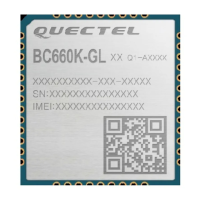NB-IoT Module Series
BC660K-GL Hardware Design
BC660K-GL_Hardware_Design 38 / 57
Figure 23: Coplanar Waveguide on a 4-layer PCB (Bottom Layer as Reference Ground)
To ensure reliable RF performance, the following principles should be complied with in RF layout design:
⚫ Use an impedance simulation tool to accurately control the characteristic impedance of RF traces at
50 Ω.
⚫ The GND pins adjacent to the RF pin should not be designed as thermal relief pads, and should be
fully grounded.
⚫ The distance between the RF pin and the RF connector should be as short as possible, and all the
right-angle traces should be changed to curve ones.
⚫ There should be clearance under the signal pin of the antenna connector or solder joint.
⚫ The reference ground of RF traces should be complete. Meanwhile, adding some ground vias around
RF traces and the reference ground helps to improve RF performance. The distance between the
ground vias and RF traces should be no less than two times as wide as RF signal traces (2 × W).
For more details on the reference design of RF Layout, see document [4].
4.5. Antenna Requirements
To minimize the loss on RF trace and RF cable, pay attention to the antenna design. The following tables
show the requirements on an NB-IoT antenna.
Table 21: Antenna Cable Insertion Loss Requirements

